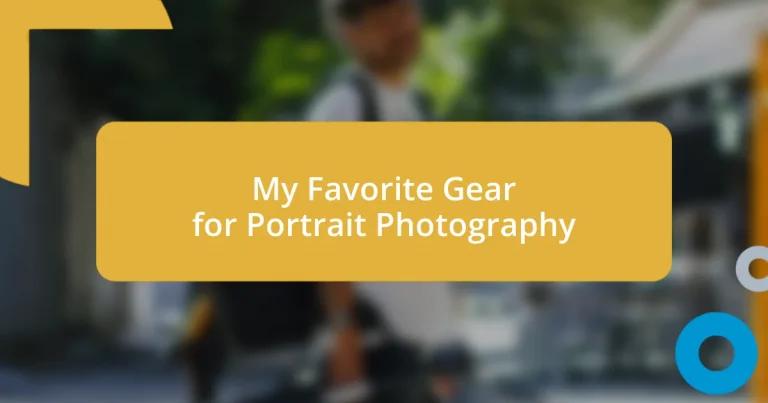Key takeaways:
- Portrait photography is about storytelling, capturing emotion, and the interplay of environment and subject expression.
- Essential equipment includes a quality lens (like 50mm f/1.8), a reliable camera body (e.g., Canon EOS 5D Mark IV), and accessories like a sturdy tripod and reflector for better composition and lighting.
- Choosing gear should consider personal shooting style and practicality, emphasizing the importance of comfort and versatility in equipment selection.
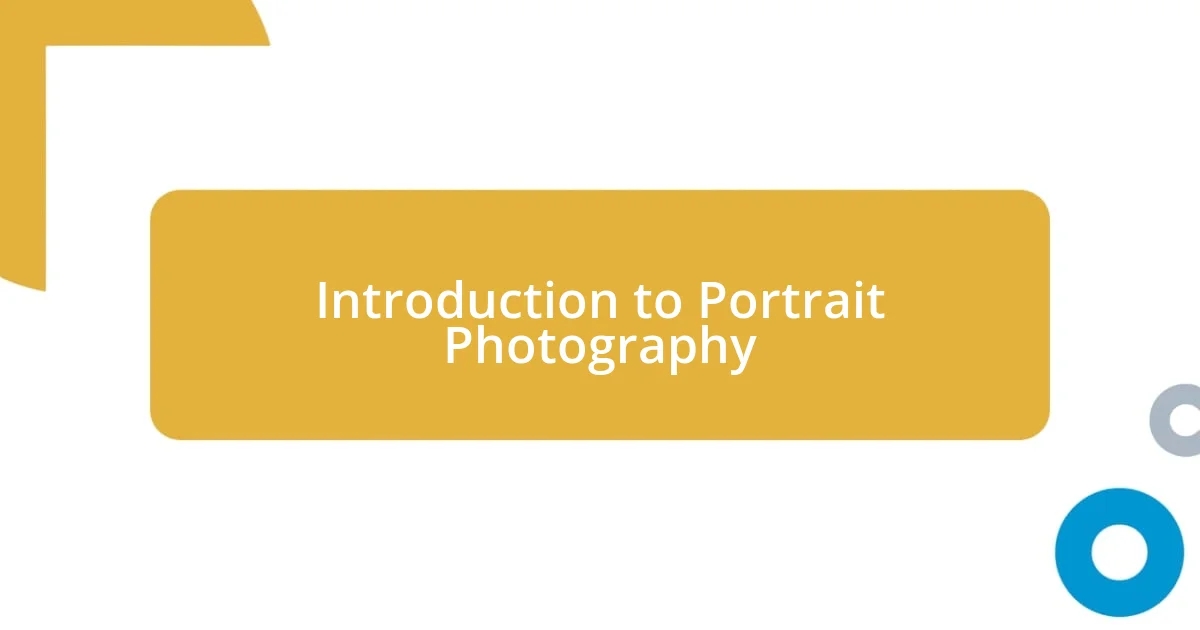
Introduction to Portrait Photography
Portrait photography is more than just capturing a subject’s image; it’s about telling a story through expression, personality, and emotion. Have you ever looked at a portrait and felt an instant connection? I remember the first time I observed a powerful portrait—it sparked a curiosity in me about how light and emotion interplay to create something truly captivating.
As I delved deeper into portrait photography, I discovered that every subject has a narrative waiting to be revealed. I often find myself asking, “What story is this person sharing with the camera?” Each session becomes a dialogue, where the subject’s demeanor and emotions guide the lens. The magic lies in those candid moments, where the subject forgets the camera is there, opening up to reveal genuine vulnerability.
Additionally, the environment plays a crucial role in shaping the final image. I once shot a portrait of a friend against the backdrop of a bustling city skyline, and the contrast between her serene expression and the vibrant chaos behind her was stunning. This experience taught me that a thoughtful setting can amplify the storytelling aspect of portraiture, creating dynamic images that resonate deeply with viewers.
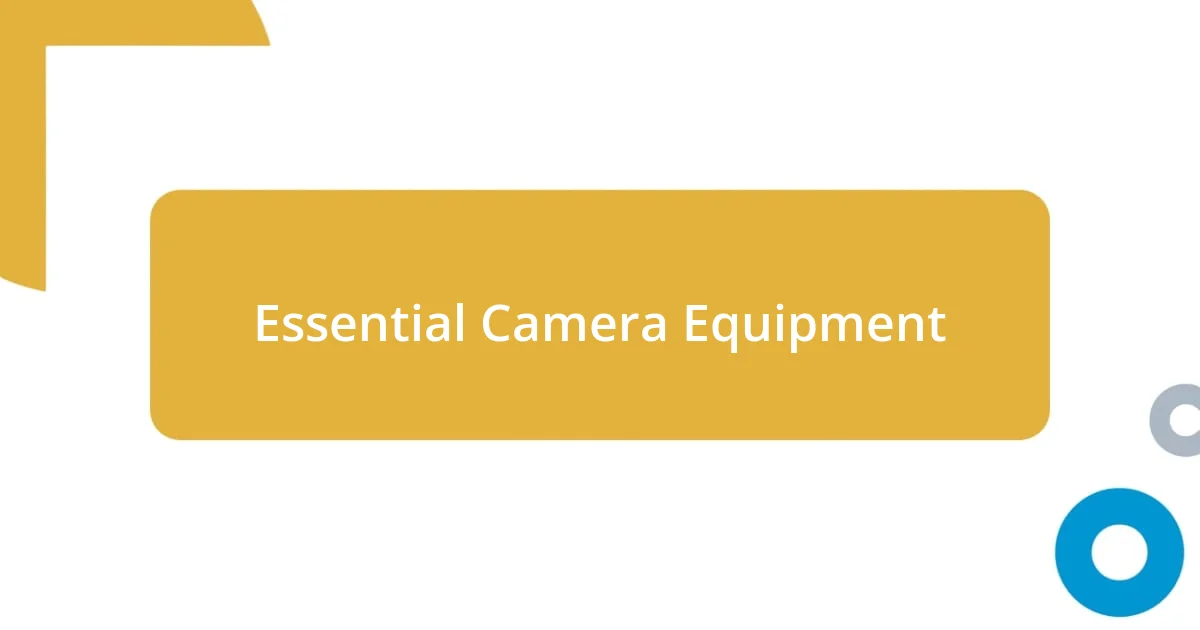
Essential Camera Equipment
When it comes to essential camera equipment for portrait photography, the lens you choose can significantly affect your results. I often reach for a 50mm f/1.8 lens, which allows me to capture stunning shallow depth of field while maintaining a natural perspective. This lens is fantastic for isolating the subject and adding that beautiful bokeh effect to the background, enhancing the emotional impact of the portrait.
A solid camera body is equally important, especially if you want to shoot in lower light conditions or need fast autofocus. In my experience, a full-frame camera like the Canon EOS 5D Mark IV provides incredible image quality and versatility. I remember a session in a dimly lit venue where the lighting was challenging, but the camera’s performance allowed me to get sharp, vibrant images that truly conveyed the mood of the moment.
Finally, don’t overlook the importance of a sturdy tripod. While it may seem excessive for portrait work, having your camera stable and at the right height can dramatically improve your compositions. I once set up a shoot with a tripod to ensure consistent framing while experimenting with different lighting setups, and it allowed me to focus more on my subject’s expressions. When I saw the final images, I felt proud of how meticulous planning paid off in capturing their personality authentically.
| Equipment | Description |
|---|---|
| 50mm f/1.8 Lens | Excellent for shallow depth of field and bokeh effects. |
| Canon EOS 5D Mark IV | Full-frame camera for low-light performance and fast autofocus. |
| Sturdy Tripod | Helps maintain consistent framing and stability. |
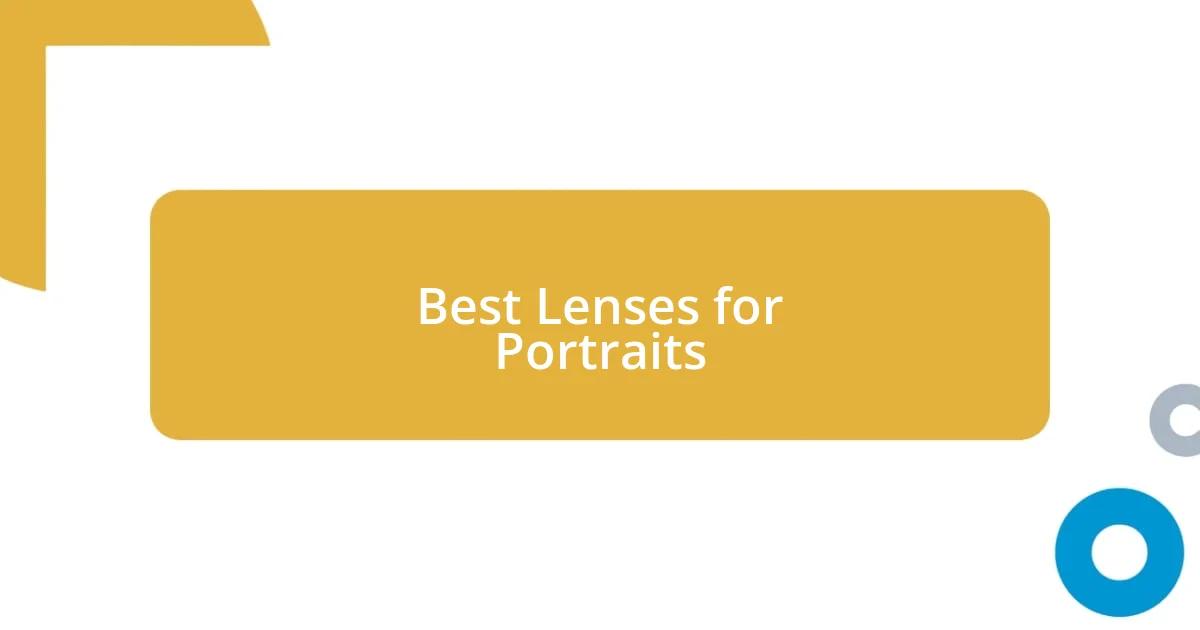
Best Lenses for Portraits
When it comes to selecting the best lenses for portrait photography, the classic 85mm f/1.8 lens stands out in my experience. I remember the first time I shot with it; the way it compressed backgrounds while beautifully highlighting my subject was nothing short of magical. With its fantastic ability to create lovely bokeh, this lens makes the subject pop, providing a sense of intimacy that truly captures essence.
Another favorite of mine is the 35mm f/1.4 lens. It offers a wider frame without compromising the subject’s presence in the image. I had an incredible session where I used this lens to capture a portrait in a small café. The lens perfectly encapsulated the cozy ambiance around my subject, adding layers to the storytelling. Here’s a brief list of my recommended lenses:
- 85mm f/1.8: Ideal for strong subject isolation and beautiful bokeh.
- 35mm f/1.4: Great for environmental portraits, blending the subject with their surroundings.
- 50mm f/1.4: A versatile option that balances between portrait and candid styles.
- 70-200mm f/2.8: Perfect for versatility, allowing you to shoot from a distance while maintaining excellent quality.
These lenses have each contributed their unique flavor to my portrait photography, elevating the emotional depth of my images. There’s nothing quite like capturing the nuances of a person’s expression while using the right lens to frame their story.
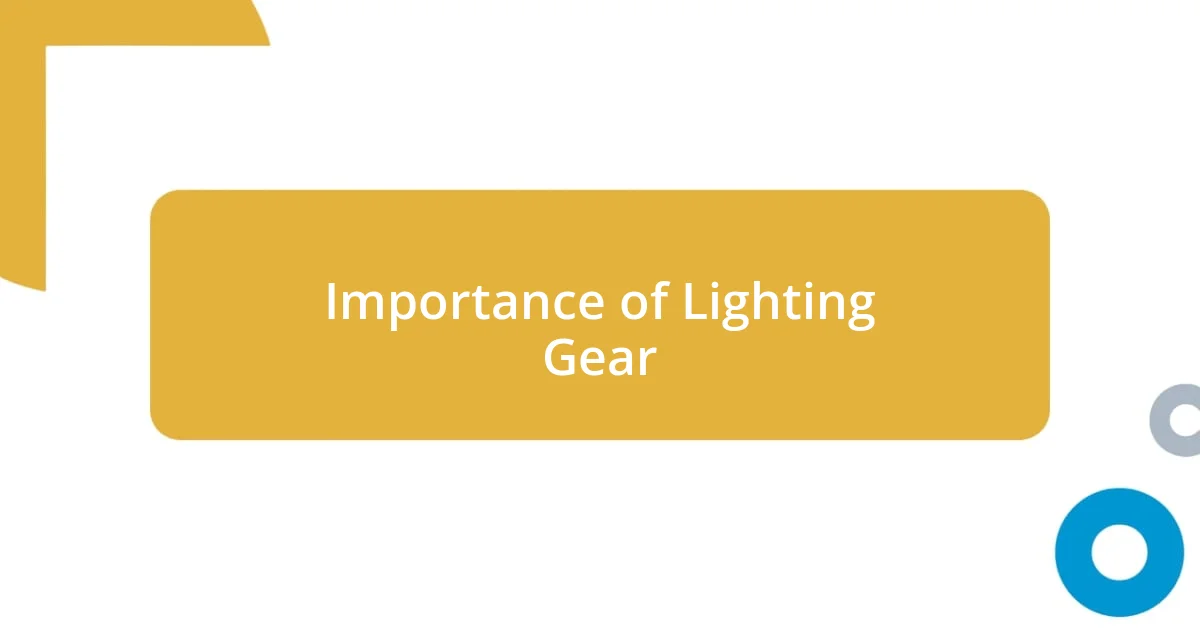
Importance of Lighting Gear
Lighting gear is absolutely crucial in portrait photography. I once participated in a shoot where I had only natural light to work with, and although the results were decent, I felt something was missing. Reflecting on that experience, I realized that proper lighting can transform an ordinary image into an extraordinary one, emphasizing my subject’s features and creating mood.
Consider this: how often have you taken a portrait that seemed flat or lifeless? I know I have. It wasn’t until I invested in a good softbox that I truly understood the power of controlled light. The soft, diffused light from that softbox added depth and warmth to my portraits. Capturing the subtle highlights on the subject’s face suddenly brought their expressions to life and made them feel more relatable.
In my journey, I’ve learned that not all light is created equal. For example, using a ring light changed the game for my close-up shots. The even illumination it provides not only removes harsh shadows but also creates those beautiful catchlights in the eyes. There’s something magical about seeing that sparkle when I review the images later—it tells a story in itself, doesn’t it?
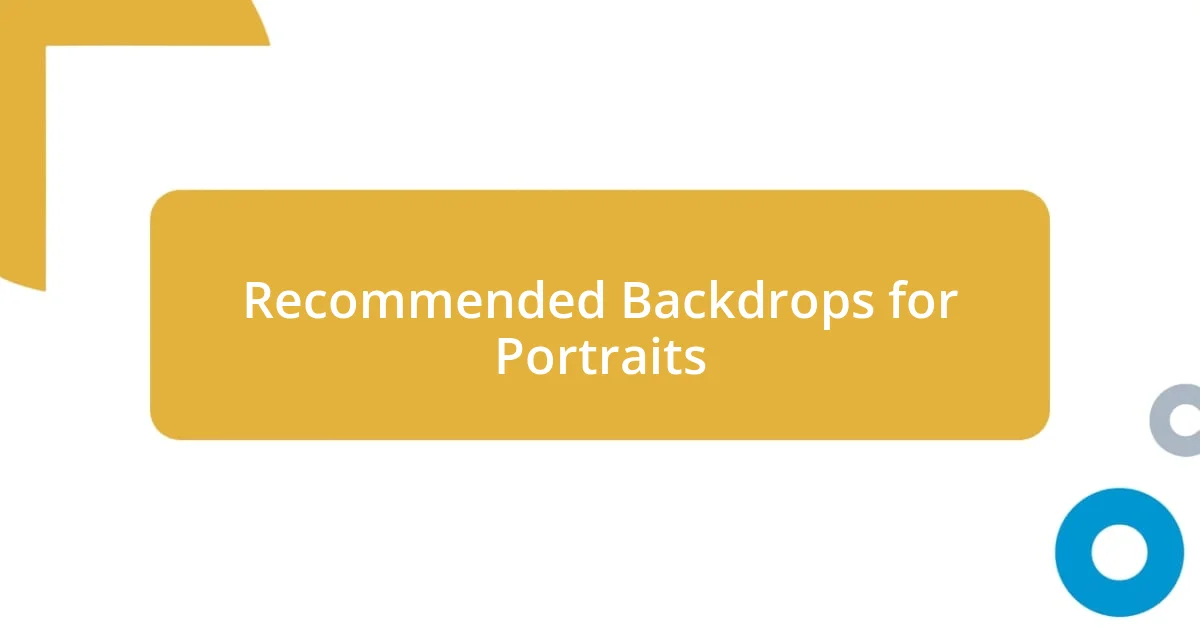
Recommended Backdrops for Portraits
Backdrops play a crucial role in portrait photography, setting the mood and enhancing the subject. I fondly recall a session where I used a simple, rich emerald green backdrop. The way it complemented the model’s vibrant red dress was pure harmony. The colors created a stunning visual dynamic that drew the viewer into the image, instilling a sense of elegance and warmth.
Another backdrop that I find incredibly versatile is a textured wall or fabric. During a recent shoot, I used an old brick wall that added character to the portraits, inviting a rustic vibe. The subtle imperfections of the wall blended beautifully with the model’s personality, telling a story of authenticity. It’s amazing how something as simple as background texture can add layers of meaning to a portrait.
If you’re looking for a more neutral option, I often recommend using a seamless paper backdrop. I once had a session with a client where we chose a soft gray, and it transformed the entire mood of the shoot. It allowed the focus to remain entirely on my subject, creating a timeless feel. Do you ever feel like a background can actually overshadow the subject? I know I have, which is why I advocate for thoughtful backdrop choices—they should enhance, not distract.
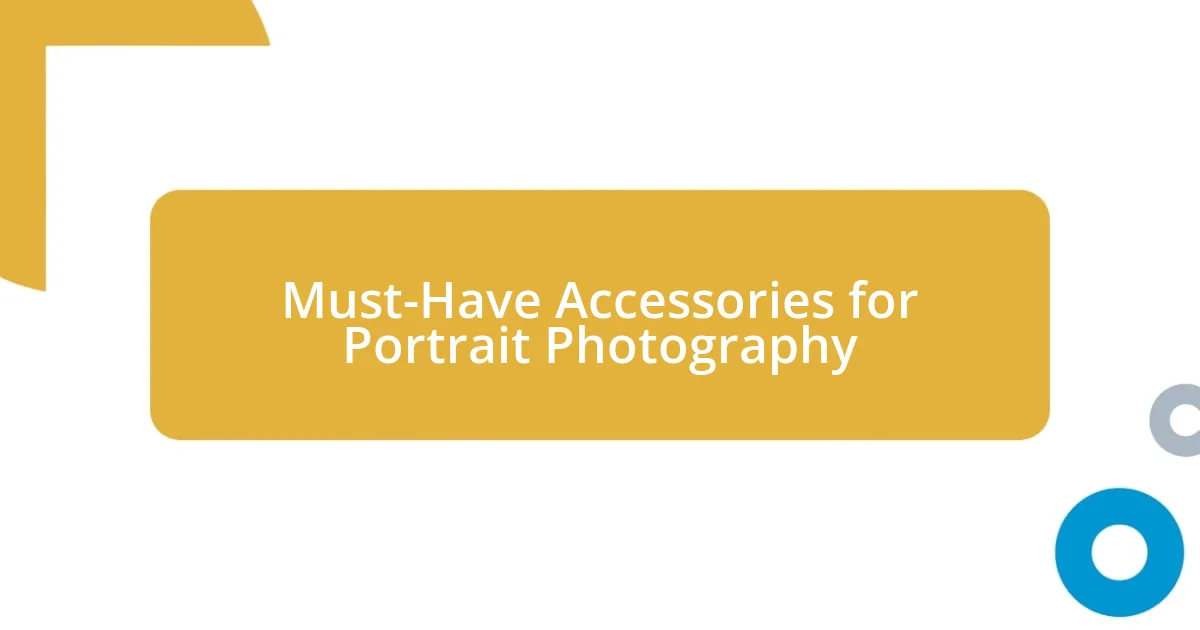
Must-Have Accessories for Portrait Photography
When it comes to must-have accessories in portrait photography, I believe a quality reflector is essential. I remember a shoot where I had to work under harsh midday sun. The harsh shadows it cast on my subject’s face were challenging. That’s when I pulled out my trusty reflector. It transformed the light, filling in those shadows and allowing the tones to blend beautifully. Have you ever struggled with shadows ruining a good portrait? A reflector can be a simple yet powerful solution.
Then there’s the importance of a sturdy tripod. In my early days, I often opted to shoot handheld, thinking it lent a more organic feel. However, during a long session, my hands began to tire, and I found myself missing the perfect shot. Once I invested in a reliable tripod, it changed my perspective. Suddenly, I could frame my subject precisely while ensuring sharpness and clarity, regardless of the lighting conditions. How much better would your portraits be with the stability that a tripod provides?
Finally, I can’t stress enough the value of a remote shutter release. It’s a little accessory that has made a massive difference. I recall a beautiful outdoor shoot where I wanted to be part of the picture too. By using a remote, I was able to set up my camera and jump into the frame with my subject. It gave me the freedom to be creative and spontaneous. Have you ever wished to capture those candid moments with yourself in the action? A remote shutter release makes that wish a reality, allowing for a more dynamic interaction in your photography sessions.
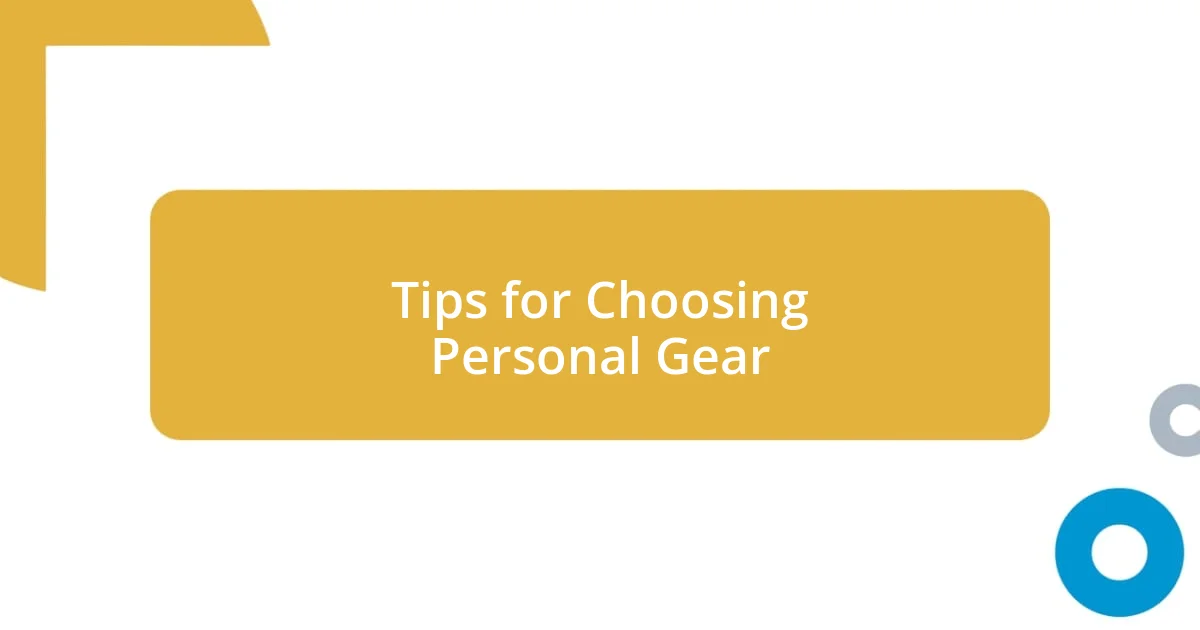
Tips for Choosing Personal Gear
Choosing personal gear for portrait photography can feel overwhelming at first. When I began, I didn’t know which lenses to prioritize. I remember investing in a prime lens that turned out to be a game-changer for my work. The sharpness and bokeh it delivered allowed me to isolate my subjects so beautifully. Have you ever noticed how a good lens can elevate a photo from ordinary to extraordinary?
Another tip I’d share is to consider the functionality of your gear. For instance, I once bought an expensive camera bag that looked fantastic but was awkward to carry. During a remote shoot, it hindered my mobility, making it harder to engage with my subjects. I learned quickly that comfort and practicality should be top priorities. Think about how your gear works with you rather than against you—can you easily access your equipment while maintaining a connection with the people you’re photographing?
Lastly, always factor in your shooting style when selecting gear. I enjoy a mix of staged and candid shots, so I lean toward versatile equipment that can handle both. I vividly recall a session where I used a hybrid camera with both DSLR features and mirrorless advantages. It was like having the best of both worlds! I found that the flexibility in capturing moments made a real difference in my portraits. What does your ideal shooting style look like, and how can your gear support that vision?












